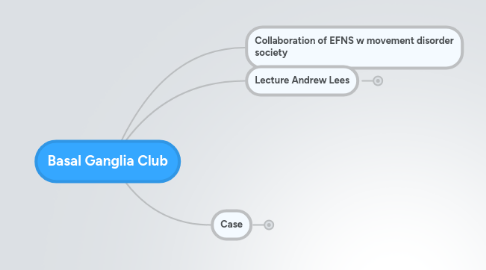
1. Collaboration of EFNS w movement disorder society
2. Lecture Andrew Lees
2.1. Nosology of Parkinson's Disease
2.1.1. What is a disease?
2.1.1.1. recognized etiologic agent or well defined pathological process
2.1.1.2. identifiable group of signs and symptoms
2.1.1.3. consistent anatomical changes
2.1.2. Parkinsonian syndromes
2.1.2.1. Parkinson's disease
2.1.2.2. much more
2.1.3. The neurologists "tools of the trade"
2.1.3.1. no notes
2.1.4. Whats in a name
2.1.4.1. Clinicians
2.1.4.1.1. the shaking palsy
2.1.4.1.2. paralysis agitans
2.1.4.1.3. parkinson's disease
2.1.4.1.4. idiopathic parkinsonism
2.1.4.1.5. parkinsons-lewy complex
2.1.4.2. Patients
2.1.4.2.1. people w parkinson's disease
2.1.4.3. In support of eponyms
2.1.4.3.1. patients prefer often eponyms
2.1.5. Parkinson's Disease
2.1.5.1. a bradykinetic syndrome characterised by L-dopa responsiveness
2.1.5.2. Definition of Bradykinesia (Queen square Brain bank criteria step 1): "slowness of initiation of voluntary movement with progressive reduction in speed and amplitude of repetitive actions" - Gibbs 1988
2.1.5.2.1. PSP fast movement, yet small amplitude, no progressive reduction in velocity and amplitude is noted
2.1.5.2.2. PD progressive reduction in velocity and amplitude is observed in a PD
2.1.5.3. Pill rolling tremor
2.1.5.3.1. tremor DOES respond to L-dopa
2.1.5.4. Listen to the patient he's telling you the diagnosis
2.1.5.5. Benign tremor dominant parkinsonism
2.1.5.5.1. SWEDDS (see previous mindmap for abbrev)
2.1.5.6. Risk factors for functional decline in PD
2.1.5.6.1. age of onset
2.1.5.6.2. axial symptoms vs tremor dominance
2.1.5.6.3. Paper J Evans, 2011 - the natural history of treated parkinson's disease in an incident, community based cohort
2.1.5.7. Dementia in PD
2.1.5.7.1. missed note
2.1.5.8. Relationships between age and late progression of PD: a clinico pathological study
2.1.5.8.1. Peter A Kempster, Brain 2010
2.1.5.8.2. The advanced disease phase played out in a similar phase whatever age it occurred
2.1.5.9. Lewy-and alzheimer type pathologies in PD dementia: which is important?
2.1.5.9.1. Yaroslau compta, Brain 2011
2.1.5.10. More than one Parkinson's Disease..
2.1.5.10.1. missed note
2.1.5.11. Brain stem pathology in PD: an evaluation of the Braak stagng model, study by Kingsbury
2.1.5.12. We still need to study where the non motor symptoms come from!
2.1.5.13. Functional somatic syndromes
2.1.5.13.1. fatigue
2.1.5.13.2. sleep difficulties
2.1.5.13.3. diarrhoea and cramping
2.1.5.13.4. poor concentration
2.1.5.13.5. rheumatic non articular pains
2.1.5.13.6. urinary frequency and dysuria
2.1.5.13.7. mood disturbances
2.1.5.13.8. temperature dysregulation
2.1.5.13.9. We need to be carefull in considering this in context of PD or not
2.1.5.14. The new neurology
2.1.5.14.1. slide
2.2. The David Marsden Lecture
2.2.1. Neurmelanin studies, 60s
2.2.2. PD was much more than melanin
2.2.3. short video: on next 40 years in neurology
3. Case
3.1. case: Baby between 3 and 18 months of age
3.1.1. 3 main signs: boobing head, torticollis, intermittent nystagmus, benign spontaneous improvement within 2 to 3 years
3.1.2. Differential diagnosis: tumor of the optic tracts, hydrocephalus
3.1.3. diagnostics
3.1.3.1. MRI
3.1.4. symptomatological diagnosis
3.1.4.1. Spasmus nutans
3.2. Case: 1 year old
3.2.1. desert comes closer, and baby starts moving more
3.2.2. Baby is fully alert
3.2.3. Driven by the environment
3.2.4. shuddering, shivering attacks
3.2.4.1. dd epilepsias
3.2.4.2. Full consciousness, trigger by excitment = normal
3.2.4.3. w maturation of the brain this disappears
3.3. case: Child reading a book, 7 years old
3.3.1. hands making stereotypical movements
3.3.2. bilateral
3.3.3. asymmetrical
3.3.4. likes reading a book over and over again
3.3.4.1. when atrtacted by something interested
3.3.4.2. when somethign is more interesting it stops
3.3.5. Syncinesia
3.3.5.1. physiological ntil the age of 7 years
3.3.5.1.1. familial susceptibility
3.3.5.1.2. sometimes persists in adulthood
3.3.5.1.3. triggered by emotion and excitement
3.4. Case: baby
3.4.1. trigemino-oculomotor synkinesis
3.4.1.1. aberrant innervation III to V nerve
3.4.2. abnormal
3.4.3. may cause embarassment depending on gender/age
3.5. Case report
3.5.1. 51 year old male, myoclonic movements
3.5.2. lost 8 kg of weight due to the movements
3.5.3. jerky movements at rest or in action
3.5.4. Alcohol consumption
3.5.5. Dystonia
3.5.5.1. neurometabolic disease
3.5.6. diagnosis: Myoclonic dystonia
3.6. Case report
3.6.1. history of present illness
3.6.1.1. weight loss
3.6.1.2. Dystonia
3.6.1.3. slowness
3.6.1.4. Asymmetrical left side more effected
3.6.1.5. posturing
3.6.1.6. Bradykinesia
3.6.1.7. Standing up apraxic
3.6.1.7.1. walking unaided
3.6.1.8. Applause sign positive
3.6.1.8.1. supposed to clap 3 times
3.6.1.8.2. but keeps clapping
3.6.1.9. progressive dementia
3.6.1.10. expressive aphasia and dysartria
3.6.1.11. ideomotor and constructive apraxia, agraphia, finger agnosia, acalculia
3.6.1.12. etc
3.6.1.13. Rapid progress
3.6.2. labs:
3.6.2.1. New node
3.6.3. EEG
3.6.3.1. unspecific slowing
3.6.3.2. periodic epileptic discharges
3.6.4. MRI and PET
3.6.4.1. normal
3.6.5. Diagnosis
3.6.5.1. cortico-basal syndrome
3.6.5.1.1. para neoplastic
3.6.5.1.2. prion
3.6.5.2. prion genetics test
3.6.5.2.1. missed
